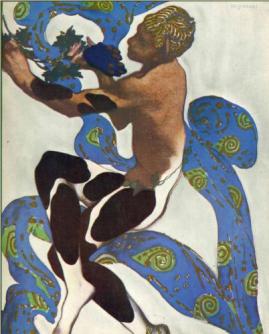Fashion in the Arts: A Powerful Collaboration of Creative Minds
by Alexandra Holness

Zandra Rhodes stands in front of costumes for English National Opera’s production of Aida. Photo Credit: London Evening Standard
At curtain call for opening night of The Pearl Fishers at Pittsburgh Opera on Saturday, November 12, 2011, a striking figure with bright magenta hair was welcomed onto the stage by a roaring applause. Though her sequined colorful frock and thick black eyeliner matched the exotic spectacle of Bizet’s coastal dream world behind her, she was not one of the opera singers, but rather costume and set designer, Zandra Rhodes. And no, it is not customary for designers to step out from behind the scenes for such a moment of glory.
Though she is certainly highly regarded for designing numerous operas around the world, Rhodes is better known for her role as fashion designer. At age 70, Rhodes stands as one of the most influential English fashion designers of the last century, with a clientele that includes Princess Diana, Freddy Mercury, Jackie Onassis, Elizabeth Taylor, Debbie Harry and Kate Moss. As “one of the new wave of British designers who put London at the forefront of the international fashion scene in the 1970′s”[1], it is no surprise Rhodes’ name headlined the Pittsburgh Opera production.
The curtain call reflected an aspect of collaborative art forms that we may overlook, and unfortunately so. Opera — like ballet, drama, and film — is a venture of both sound and sight, one involving a rich collaboration of composer, singer, musician, set designer, and yes, costume designer. It is interesting to note that in the case of The Pearl Fishers, the most widely known star was Rhodes. She brought much needed appeal to this more traditional art form that always yearns for audiences, and this fact suggests a potentially lucrative partnership between fashion and art that is perhaps not capitalized upon enough by arts managers.
This is certainly not the first time the world of fashion has had a conspicuous role in traditional art forms. Drama and dance have long known the power of costume. The very beginnings of ballet unfolded with grand spectacle in the court of Louis XIV and the work of Jean-Baptiste Lully, and it is in ballet that we find one of the most famous collaborations between performing art, visual art, and fashion: Sergei Diaghilev and Leon Bakst. In 1909, the opening of Diaghilev’s Ballets Russes featured costumes by the painter Bakst. The colorful, sexy, glamorous and fashionable spectacle sparked a near style revolution in Paris, which in turn, created commercial attraction for the ballet. The Ballets Russes immediately influenced the work of seminal fashion designers of the time, such as Paul Poiret and Coco Chanel, and in return, The Ballets Russes’ subsequent performances featured costumes and designs from some of the world’s most famous artists such as Pablo Picasso, Henri Matisse, Giorgio de’ Chirico, Joan Miró, Georges Braque and Coco Chanel. “In 1914, an article in Tatler said that the Ballets Russes’ ‘extraordinary scenery, the even more extraordinary dresses, the most extraordinary color schemes… upset all our preconceived ideas concerning ballet dancing and pantomime’ ”[2]. The costumes of the Ballets Russes ignited an explosive relationship between fashion and the Russian ballet, each fueling the success of the other. The visual spectacle of the ballet linked so closely with the fashion world brought commercial viability and sustainability to what might have otherwise been a lost or obscure art form.
The partnership between art and fashion certainly does not end there. Elsa Schiaparelli, one of the most prominent fashion designers of the mid-20th century, is most known for her surrealist aesthetic. Schiaparelli often collaborated directly with artists such as Salvador Dali, Jean Cocteau, Meret Oppenheim, and Alberto Giacometti. Her most distinctive, well-known and memorable pieces were those that were produced in collaboration with Dali. The products of this collaboration – the lobster dress, the tears dress, the skeleton dress, the shoe hat – catapulted the Italian fashion designer to world-wide fame and success, while at the same time bestowing additional commercial viability and sustainability upon the surrealist art movement.
In our day the rich relationship between art and fashion is surely most evident in film and television. The work of Edith Head has transcended well beyond film in its influence, and her artistry made her the most highly awarded woman at the Academy Awards (eight, outpacing Katherine Hepburn by four). It has become commonplace for fashion designers to use film and television as a platform to feature their designs. In turn, featuring these fashion designers often serves to catapult films and series to commercial success and bestow upon them a visual legacy. For example, who doesn’t associate Breakfast at Tiffany’s with Audrey Hepburn’s little black dress designed by Givenchy? What would the Wizard of Oz been had Judy Garland not worn those ruby red slippers designed by Adrian? Would the series Sex and the City have been as big a cultural phenomenon if Sarah Jessica Parker hadn’t been running around town in Manolo Blahniks, Jimmy Choos and Christian Louboutins? And for pure visual spectacle, it is hard to match The Black Swan, which certainly owed a substantial part of its success to Rodarte’s designs.
The partnership between fashion, costume and film suggests that fashion might well serve other areas of the arts as a gateway to commercial exposure and profitability. It is no secret that in this economic climate, most arts organizations are struggling to remain relevant, sustainable, and commercially viable. The link between fashion and other arts perhaps offers one more element contributing to survival and sustainability.
For related articles on The Muse Dialogue:




In our day the rich relationship between art and fashion is surely most evident in film and television.
I thought of Eiko Ishioka: I discovered her through the extraordinary costumes she designed for Tarsem’s The Fall (2008).